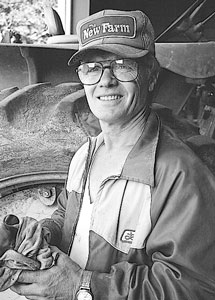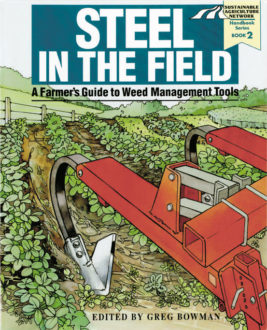
Agronomic Row Crops: The Farmers
No-Chemical Control Regime Integrates Timing, Tools, Covers
Carmen Fernholz
Madison, Minnesota
- 300 acres
- four-year crop rotation
- conservation tillage (30 percent residue)
- feed/cash crops: corn, soybeans, spring wheat, oats, barley
- cover crops of red clover, annual alfalfa, berseem clover
Weed management highlights
Strategies: delayed planting into warm soil... crop rotation... high-tilth soil with increasing organic matter... mechanical controls
Tools: low-residue C-shank cultivator (front and rear mounts)... standard rotary hoe... field cultivator... chisel plow
Canada thistles have kept Carmen Fernholz from trying to pioneer drilled no-till, no-herbicide soybeans. His sustainable system already earns him honors in production efficiency, but he wants to build on that successful foundation through even more cost-effective weed control.
In '96, scientists working on his farm with an experimental Pseudomonas bacterium had 'tremendous success' infecting - and controlling - the prickly pests and other weeds. Fernholz's goal is to combine this natural weed disease with especially competitive, weed beating soybean varieties. That's the kind of persistent innovation that allows him to manage potentially serious competition from wild sunflowers, foxtail and cocklebur while reducing tillage passes. His approach is to coordinate a host of compatible practices, each of which helps to lower weed pressure.
Fernholz combines tilth-building soil management, keen soil temperature observation and precisely timed tillage during the early season to check weeds. His cultivation quest is to disrupt weeds close to the plants early in the crop cycle, with a minimum of soil disruption. He knows excess tillage burns soil organic matter and increases erosion risk.
Fernholz has shown that his basic system makes money (and saves soil) through his entries in the MAX program - a maximum economic yield analysis established by Successful Farming magazine. In '92 his 51 bushel per acre soybean entry following a hairy vetch plowdown with 18 percent residue earned a net profit of $99.63 per acre, as calculated by the MAX formula. That ranked him in the top 25 percent of bean entries from 16 states. The entry's weed control consisted only of three cultivations. His soil loss was estimated at 1.8 tons per acre - substantially below his county's average soil allowable figure of 5 tons per acre.
In '93, cool weather reduced yield to 43 bushels per acre and MAX profit to $33.16 per acre, using a standard $5.35 per bushel sale price. But his certified-organic beans sold for $9.75 per bushel, giving him an actual profit of $222 per acre on the no-herbicide, soil loosening crop.
His top four weed-management points are
Cover crops to improve soil structure.
Red clover, Nitro annual alfalfa and berseem clover are his favorite covers because of their ability to loosen up soil. Fernholz wants a crumbly, coarsely granular structure to create the optimum environment for vigorous development of crop roots. It also maximizes the weed-killing effect of his implements, allowing them to uproot weed seedlings and not create clods or slabs.
He seeds these soil-builders at 12 to 15 pounds per acre ('lots of seed to assure a strong, competitive stand') in his small grains, which serve as nurse crops. Strong stands keep opportunistic fall grasses from invading.
He applies manure immediately after grain harvest, lets the legume grow through late fall, then chisel plows the field about 7 inches deep. The result is a rough surface that traps snow and enough residue to prevent erosion.
When the soil is warm, he uses a Field Cultivator (9-inch sweeps with 3 inches of overlap) to eliminate surviving legume plants and spring weeds. He makes two passes about 4 inches deep - one at 45 degrees to the row, the second with the row. 'Moving from six inch sweeps with hardly any double coverage up to the nine-inch sweeps made a night and-day difference' in the tool's weed-killing ability,' he reports. Adding to their effectiveness is their 'full-width' engineering which causes the sweeps to maintain their full cutting width as they wear down.
The passes take care of the first round of redroot pigweed and foxtail, which germinate at about 50ÞF - the same temperature as corn. He seeds corn into warmed, weed-free soil where the crop has the best chance to out-compete the next round of weeds.
Planting tied to soil temperature.
To kill more early weeds with tillage and to give his crops faster germination, Fernholz waits to till and plant until his soil remains at 50ÞF or higher for several days. Because daily temperatures in the planting zone fluctuate considerably as the soil gradually warms in spring, he waits until he finds consistent readings with his soil thermometer located 5 inches deep.
Waiting on warm soil means Fernholz starts planting corn about three weeks later than his 'early-bird' neighbors. But he sees quicker emergence, often within 8 to 10 days - and often ahead of corn around him planted earlier into colder soil. His robust corn seedlings move more quickly through their development, lessening the period they are most vulnerable to competing weeds before producing a weed-shading canopy.
Rotary hoe pass five days after planting.
'unless it's too wet.' Fernholz faithfully makes this pass whether or not he sees any weeds breaking through the surface. 'You don't know how important the pass was until it's too late,' says Fernholz. You can use a non-sprayed skip as your 'weedy test' control plot. He uses a 30', flex-wing, standard John Deere rotary hoe.
He runs it at just 5 to 6 mph - about half as fast as the speediest operators - and also breaks the normal practice by raising the gauge wheels to allow the teeth to penetrate way down to about 4 inches. 'I have virtually no crop damage because anything with a good root stays put at the slower speed. But the deep aeration really bothers the thin grass roots and gives me excellent control.'
He's found the best conditions for knocking out weeds come on dry days when air temperature is at least 75ÞF and there's a 10 to 12 mph wind, regardless of the implement used. In moister or cooler conditions, hoeing can still benefit the crop by setting back weed growth.
Simple, appropriate tooling.
Fernholz uses a low-residue, conventional John Deere cultivator retrofitted with low-profile, 6-inch sweeps on flexing, flat-stock, curved C shanks. (Chisel-plow type shanks - used on maximum-residue cultivators - are the same shape but are much thicker steel and rigid.) The sweeps glide through the top 2 to 3 inches of his loose soil with hardly a ripple in the flowing action. They run flatter than the former sweeps (that were mounted on vertical standards) thanks to the forward-sloping angle of the C-shank's attachment point. By staying consistently shallow, the flatter sweeps don't gouge down to scour up lumps of soil that threaten young corn plants as the old ones did.
Crop damage, loss of alignment with the row and even toolbar damage was a problem with the more pitched shovels on the unit's old straight shanks. 'Yes, the cushion springs were supposed to protect against rocks, but after a few seasons outside, the springs become too stiff to flex,' Fernholz found out. The lively action of the C-shank gives a consistent soil flow with much less adjustment during use. This is because 'It's virtually immune to disturbances from rocks,' Fernholz says. Consequently, the new hardware means he can set the sweeps closer to the row, experience less crop loss, drive faster, and worry less as he goes through the field.
He usually cultivates twice per field - three times if wet conditions allow weeds to resprout. Target depth is about 1.5 inches. He stays shallow to preserve moisture and stimulate as few weed seeds as possible.
Seven sweeps per row give weeds no place to hide. Fernholz runs four sweeps per row on a frame-mounted, front toolbar positioned just behind the front axle. He doubles coverage with three sweeps per row on a rear-mount toolbar to obliterate wheel tracks and further disrupt surface weeds.
Even with excellent soil tilth that boosts water infiltration, Fernholz knows that each tillage pass burns up humus - the most soil-enriching form of organic matter - and leaves his fields more vulnerable for a time to water-caused erosion. He's focusing his management research on corn, the one year out of four he will still have relatively exposed soil in a row crop during early summer rains once he breaks the barrier to organically certifiable, solid seeded beans.
